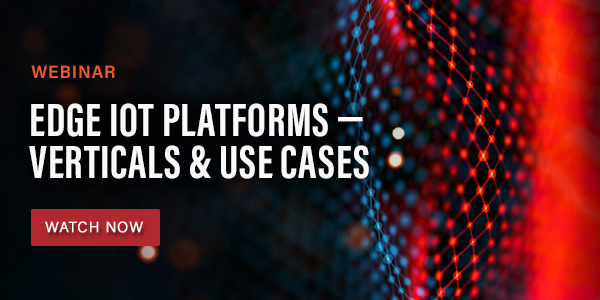This blog outlines the Q&A part of the joint STL Partners and Volt Active Data webinar on Edge IoT platforms in February 2023. The speakers are David Rolfe, Head of Product Marketing, Volt Active Data; Joe Hurman, Senior Consultant, STL Partners; and Dalia Adib, Director, STL Partners.
On Feb. 21 we hosted a webinar with STL Partners called, “Edge IoT Platforms: Verticals and Use Cases Driving Real Growth in 2023”.
Here’s the Q&A from that webinar.
1. How close does the edge need to be hosted to the end premise?
Joe Hurman, STL Partners: This completely depends on the practicalities of the use case and the benefits that an enterprise is seeking to unlock by utilizing an edge location. For example, when running video analytics for manufacturing, large amounts of data need to be collected and processed at a single location to ensure speed and reliability and reduce data backhaul costs.
However, a network edge deployment may be more appealing – potentially to suit different regulations (e.g., in financial services where specific regulation dictates certain personal data may not leave the country), in situations where the low latencies offered by an on-premise deployment are not required, and in scenarios where the data collection or processing is distributed and there is no centralized ‘premise’ (e.g., content delivery, several smart city use cases).
2. How do you see different verticals adopting different types of edge (device vs. on-prem vs. network edge)? Are there key factors leading/influencing this adoption?
Joe Hurman, STL Partners: Much of this question is also answered by the question above. In addition, the popularity of different use cases, as well as broader network requirements, will drive different verticals to have a preference for device vs. on-premises vs. network edge computing.
Healthcare, for example, would likely benefit from on-premise edge computing due to the critical nature of their use cases, requiring high network reliability and the necessity of maintaining patient data with a high level of security – best enabled by the data localization offered by an on-premise deployment. In comparison, verticals that are more distributed in nature, such as smart cities, would likely benefit from network edge deployments that can serve devices across a geographically disparate platform.
With respect to verticals that would benefit from on-device edge computing, those with use cases that require ultra-low latency and reliability, such as autonomous vehicles, would likely require significant on-device edge computing to ensure that if network coverage was lost then they could still operate safely, even if this was combined with some network edge deployments.
3. Question for David. It would seem that many edge applications would need an orchestration platform. Does that imply AI is going to play a big role?
David Rolfe, Volt Active Data: That would depend on what you see AI being used for. I’m still not sold that AI will be a revolution. Maybe. Maybe not. I can see many use cases involving optimization and planning of activities – that’s fairly clear-cut. But given the very high failure rate technologies like GPT have in real-world situations would you really put it in charge of say, a china shop?
4. What type of SLAs are relevant and viable for IoT applications across the disaggregated ecosystem of partners required in vertical applications?
Joe Hurman, STL Partners: Downtime is always a key metric for any business-critical use cases, measuring the availability of a specific device or system of devices. Enterprises need to ensure that the touted reliability benefits of edge are being combined with reliable IoT devices to ensure this benefit is being realized in the deployment. In particular, any automation-enabled IoT platforms may have strong dependencies across the business process they enable, assuming no workarounds are implemented to cover the edge case where a technical fault within an IoT device disables the associated business process. For these more tightly coupled platforms, availability is a key factor, with downtime the associated SLA is used to monitor this.
In addition, the other element of overall reliability, other than the availability referenced previously, is latency. Many OT applications would require significantly lower latencies than IT (around 5ms versus 100ms respectively), so ensuring IoT devices are compatible with these requirements is also paramount, and tracking latency both across an automated workflow and within its components is a must.
5. How mature are the leading-edge computing platforms? And which are those major platforms? How are companies monitoring edge platforms/computing devices? What are the popular solutions in the market?
Joe Hurman, STL Partners: The edge market is still in its relative infancy, and therefore we are still seeing a fairly fragmented market with no clear market leaders across all verticals. The variety of use cases for edge mandates different hardware, middleware, and software across different verticals and use cases, so it’s very difficult to give an answer on who the overall market leaders are in each of these areas. For more information on some of the companies who are driving innovation at the edge, STL’s recent article on 100 edge computing companies to watch in 2023 goes into more detail on this topic.
6. Does Volt’s platform use traditional on-premise edge computing hardware or something manufactured by Volt?
David Rolfe, Volt Active Data: We run on x86 Linux, or containers, on anything from part of a core to dozens. We have a Gravitron port coming out later this year. For various obscure architectural reasons, we’re really, really efficient.
7. What are the current challenges for mature edge computing platforms?
Joe Hurman, STL Partners: I’m going to take this question from the point of view of a lead vendor of an edge platform integrating with IoT, as the challenges to enterprises will vary significantly across industries and from deployment to deployment:
There are several key challenges facing even the most mature edge and IoT platforms. The challenge which we’ve heard the most discussion of in the market currently is the management and orchestration of such a distributed system, in terms of the variety of vendors, geographical location of nodes, and the range of technologies/ devices required within the platform.
Managing a variety of vendors requires strong commercial and relationship management capabilities to ensure a vendor ecosystem is commercially architected in a way that best suits the lead vendor. Once this has been set up in a way that best facilitates the delivery of the platform, the orchestration capabilities needed to manage a plethora of heterogenous devices both across geographies and technologies are significant, and strong orchestration capabilities are key to the success of any edge platform for this reason.
In addition, the difficulty translating business requirements from the enterprise into technical
requirements which an ecosystem of partners can collaborate to deliver against is another key
challenge, let alone then having to translate these technical outcomes back into business outcomes to ensure the enterprise can measure the success (or otherwise) of deploying such a platform.
8. Would edge computing influence how IoT solutions are sold today?
Joe Hurman, STL Partners: Most current IoT platforms which are sold as a packaged solution currently are closed systems, which use connectivity such as Bluetooth or WiFi to transfer data being collected across the platform (likely through sensors or video cameras) to a single point, before this data is then transferred to a compute-enabled location (either edge, cloud or legacy on-prem) for processing. This single point takes the form of an IoT gateway, where data is aggregated and standardized, before being collected across the platform.
With the dawn of edge computing, the role of this traditionally simple IoT gateway can be expanded to include some analysis at the aggregation point, either removing the need to transfer data onto a further location for processing or reducing the quantity of data which needs to be transferred to this cloud or edge location, in turn reducing costs.
Vendors such as Dell are starting to combine the aggregation and standardization capabilities of a traditional IoT gateway with the analytics capabilities of edge compute in an ‘Edge Gateway for IoT’, facilitating this analysis of collected data at the edge.
9. How important are regional edge data centers for businesses striving toward the edge, and what are the benefits you see for using edge data centers over larger hyperscalers?
Joe Hurman, STL Partners: Using regional data centers as a form of ‘regional edge’ can produce similar benefits to a network edge deployment (albeit without the same latency and reliability guarantees associated with storing edge compute within an operator’s network). However, the key blocker to network edge deployments is the low maturity of operators’ network edge offerings.
Regional data centers exist today and have mature offerings which in some instances meet the flexibility requirements and cloud-like commercial models which allow them to meet STL’s definition of edge. Regional edge provided by data centers is also likely to be a more cost-effective solution than a network edge deployment, and for use cases such as data localization for regulatory compliance (as discussed earlier in relation to financial services), a regional data center is likely to be a more cost-effective solution that meets the requirements of the enterprise. Another consideration is the ability of a regional edge deployment to connect to all operators’ networks, as opposed to being constrained to one operator’s network with a network edge deployment.
There are various reasons why a hyperscaler deployment may not be appropriate for a given enterprise. However, even if a hyperscaler deployment would be preferable, it is not always an option. The hyperscalers have strong data center density in certain regions, but they do still have significant gaps in their data center coverage. For example, AWS, Azure, and GCP each only have one region in Africa (all in South Africa). Even in areas where it appears on first glance like they have strong local coverage, they may only offer certain services which reduce the appeal of a hyperscaler cloud deployment, but can be solved with ISV partnerships in a regional edge datacentre.
10. Can you go a little deeper into the government aspect? The public sector is enormous and has multiple segments that are very different, even after separating out defense.
Joe Hurman, STL Partners: The government sector is likely to vary significantly by country and could include IoT applications for smart cities, emergency services, public transport, education, and of course, defense. Examples of IoT applications that could benefit from edge technology in each of these sub-sectors are broad and would rely on the varying capabilities offered by edge.
Some use cases could be leveraged across most sub-sectors (e.g., smart buildings.) Edge-enabled IoT could be used in schools, hospitals, and government office buildings to enhance security (e.g., using video analytics), health and safety (e.g., condition monitoring), or energy efficiency (e.g., using sensors and edge compute to analyse data with the objective of reducing heating in rooms with no occupants).
Additionally, many of these sub-sectors have high security and reliability requirements that favor edge solutions. Defense, emergency services, and public transport could all benefit from using edge technology to increase data locality and reduce the risk of connectivity outages caused by inconsistent network traffic and services.
However, for other IoT applications, edge requirements would vary widely. Network edge may be necessary for distributed services such as public transport and emergency services, whereas on-premises (or even on-device) edge may be better suited to sub-sectors with reduced geographical distribution such as hospitals and military bases, which may prefer the data locality and ultra-low latencies offered by on-premises deployments. These comparisons can be extended across most sub-sectors with differing requirements, as edge capabilities vary significantly according to edge location.
11. Is data latency really an issue any longer? Unless we are talking about urgent, emergent situations (emergency management, combat, surgical procedures), is the latency issue not insignificant?
Joe Hurman, STL Partners: Latency is definitely driving a disproportionate amount of the hype compared to the proportion of edge IoT demand we expect to be driven by this benefit. Use cases that leverage benefits such as security, cost savings, and reduction of external dependencies (eg, on connectivity) are on balance probably further down the line in terms of relative maturity. It’s also worth noting that the majority of use cases which are expected to drive the demand for edge technology will benefit from more than just one of the touted benefits, so it’s likely that low latency will be a secondary benefit even if security or reliability are the primary drivers of deploying an edge alongside IoT.
However, even considering use cases for which the leading benefit is low latency as not significant would be short-sighted in my opinion. If we take the use cases which fall under the bucket of smart cities, there are some more futuristic, yet realistic, use cases such as autonomous vehicles, which would rely on ultra-low latency to satisfy the safety requirements of such a vehicle. Where safety is the key driver as it is here, it is likely that both the public and private sectors would be willing to pay a premium for the combination of reduced latency and increased reliability.
12. How does Volt support in this effort to reduce latency or facilitate this use cases?
David Rolfe, Volt Active Data: Volt is an unusual platform. Instead of a stack of different components, which adds latency and complexity, Volt combines logic, data storage, and streaming into a single platform that scales on a core-by-core basis. Again, geographical distance is not relevant any longer, at least not on our planet. However, if we are talking about space exploration, where infrastructure is limited, or deep sea…
Joe Hurman, STL Partners: This is an interesting point – of course currently we’re focusing on edge deployments on Earth, but who knows where the edge market will be in 10 years! Latency would become a huge issue with any deployments in space so it’s entirely possible this could be a potential long-term area of growth.
13. Can you share some use cases related to autonomous smart buildings?
Joe Hurman, STL Partners: Definitely, the following use cases can all be considered under the ‘smart buildings’ banner:
• Smart building management (utilities/ lighting)
• AGVs for cleaning/ concierge
• Advanced security solutions (video ingest and analytics)
• Smart energy management (expanding utilities to include new energy sources and vehicle to
grid EV charging)
Get in Touch
If you have any questions not addressed in the webinar or this Q&A document, or want to hear more about our research findings or from our speakers, please contact:
- David Rolfe, Head of Product Marketing, Volt Active Data, drolfe@voltactivedata.com
- Joe Hurman, Senior Consultant, STL Partners, joe.hurman@stlpartners.com
- Dalia Adib, Director, STL Partners, dalia.adib@stlpartners.com
If you have any questions intended for Volt Active Data or would like to learn more about their offerings, please contact:
- David Rolfe, Head of Product Marketing, Volt Active Data, drolfe@voltactivedata.com






